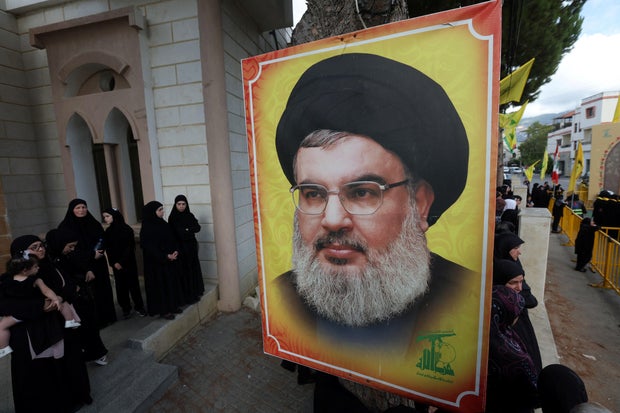Who was Hassan Nasrallah, the Hezbollah leader killed by Israeli airstrike in Beirut?

Hezbollah leader Hassan Nasrallah, who led the terror group for more than 30 years, was killed in an Israeli airstrike.
Nasrallah, 64, was killed during a massive airstrike on the Iran-backed group’s “central headquarters” in Beirut, Lebanon on Friday, the Israel Defense Forces said in a statement.
Hezbollah confirmed Nasrallah’s death, saying its longtime leader “has joined his fellow martyrs.”
The strike also killed Ali Karki, the commander of Hezbollah’s southern front, and other Hezbollah leaders, the IDF said. The leaders were in a command facility “embedded under a residential building,” the IDF said. An Israeli military official said real-time intelligence on an operational opportunity allowed them to carry out the strike.
The afternoon strike was part of a series of large explosions targeting leaders of the militant group, which has been firing rockets and drones across Lebanon’s southern border into Israel for nearly a year amid the war between Israel and Hamas.
Aziz Taher / REUTERS
Hassan Nasrallah’s background
Nasrallah was born in Beirut in 1960, the ninth of 10 children in a Shia family. His family was poor and lived an in impoverished northern suburb of Sharshabouk; his father sold vegetables. The city was then known as the “Paris of the Middle East,” but when Lebanon’s civil war broke out in 1975, the city deteriorated into disaster.
During that time, Nasrallah’s family fled Beirut. He joined a Shia militia called the Amal Movement, which later evolved into Hezbollah, which means “Party of God.” The group has been backed by Iran since its inception, according to Israeli and U.S. officials, with Iran training fighters and sending hundreds of millions of dollars annually.
Nasrallah studied in Iran for a time, then returned to the group and became Hezbollah’s secretary general after Israel assassinated his predecessor, Abbas al-Musawi, in a 1992 helicopter strike.
He held the title of “sayyid,” an honorific meant to the Shiite cleric’s lineage dating back to the Prophet Muhammad, the founder of Islam, according to the AFP.
Hezbollah under Hasrallah’s leadership
Under Nasrallah’s fiery and charismatic leadership, Hezbollah crystallized its threats to destroy Israel and the U.S. presence in Lebanon. Washington declared the organization a terror group in October 1997, five years after Nasrallah took control.
Supporters saw Nasrallah as a charismatic and shrewd strategist who strengthened bonds with leaders in Iran and militant groups like Hamas, the AFP reported, while the West and some oil-rich Gulf Arab countries saw him as an extremist.
The group’s military wing has been linked to the mass casualty bombings of two U.S. embassy buildings in the 1980s. The bombings killed more than 80 people and wounded hundreds more. Hezbollah has also been linked to airplane hijackings, kidnappings, suicide bombings and espionage around the world.
Nasrallah was credited with leading the war of attrition that led to the withdrawal of Israeli troops from South Lebanon in 2000, after an 18-year occupation, the AFP reported. He also spearheaded Hezbollah’s 34-day war against Israel in 2006.
Nasrallah also got the group heavily involved in neighboring Syria’s brutal conflict in 2011. Hezbollah fighters sided with Syrian President Bashar Assad’s forces, even as the rest of the Arab world ostracized him, the AFP reported. Hezbollah, and other key allies like Russia and Iran, helped Assad stay in power and retake territory lost earlier in the conflict.
Hezbollah has also expanded politically under Nasrallah’s leadership. After Lebanon’s civil war came to an end in 1990, Nasrallah gradually turned the organization into a “state within a state,” according to the AFP, with an elaborate social welfare network that provided schools, clinics, and housing in the impoverished and predominantly Shiite parts of Lebanon. Hezbollah continued to grow throughout the country, eventually winning elected seats in the nation’s parliament.
Nasrallah’s death leaves a void of leadership in the strongest paramilitary force in the Middle East.
Nasrallah feared assassination
Nasrallah’s public appearances became rarer, even as the profile of Hezbollah grew. Afraid of assassination, he chose to deliver speeches via video from secret locations. The messages were broadcast on Hezbollah’s own radio and satellite TV station, leading to his status as an icon in Lebanon and throughout the Arab world, according to the AFP.
In his last televised remarks, on September 19, he blamed Israel for an exploding pager and walkie-talkie attack that killed dozens of Hezbollah soldiers and wounded several thousand more. In his final words, he vowed that “retribution will come.”
Nasrallah is survived by his wife, Fatima Yassin, his three sons Jawad, Mohammed-Mahdi and Mohammed Ali, and several grandchildren, according to the AFP. His eldest son, Hadi, was killed in 1997, while fighting against Israeli forces, and his daughter Zeinab was reportedly killed in the Beiruit airstrike on Friday.










